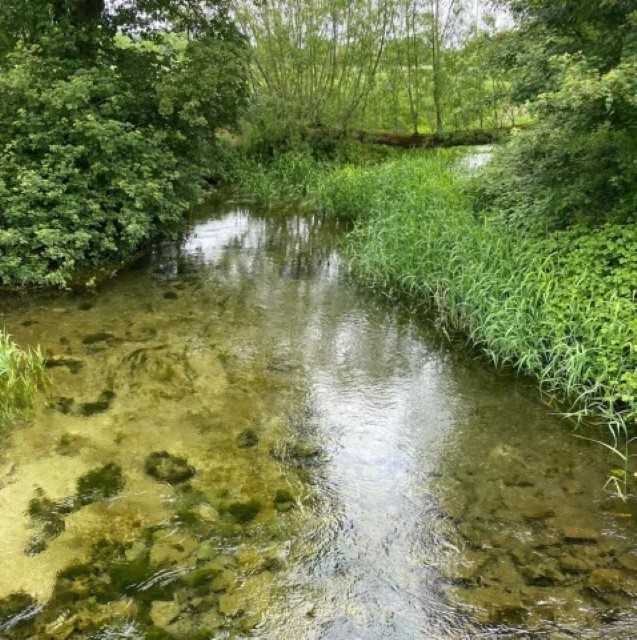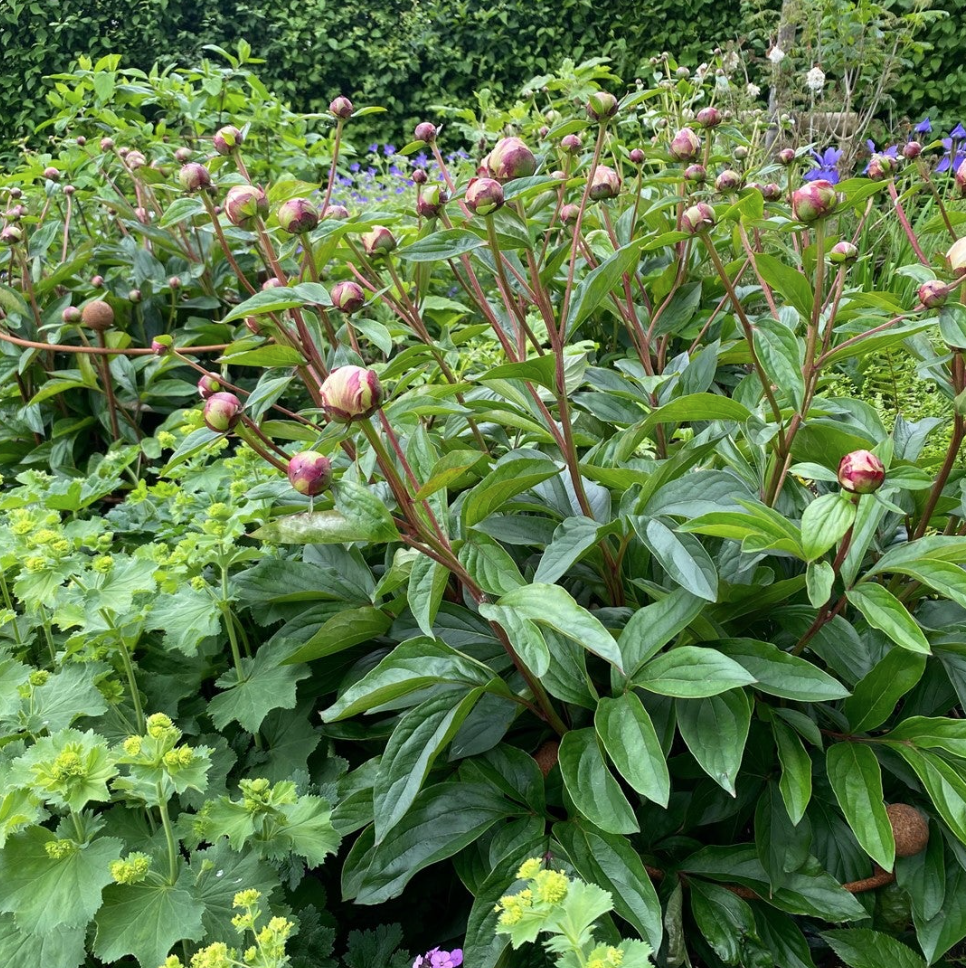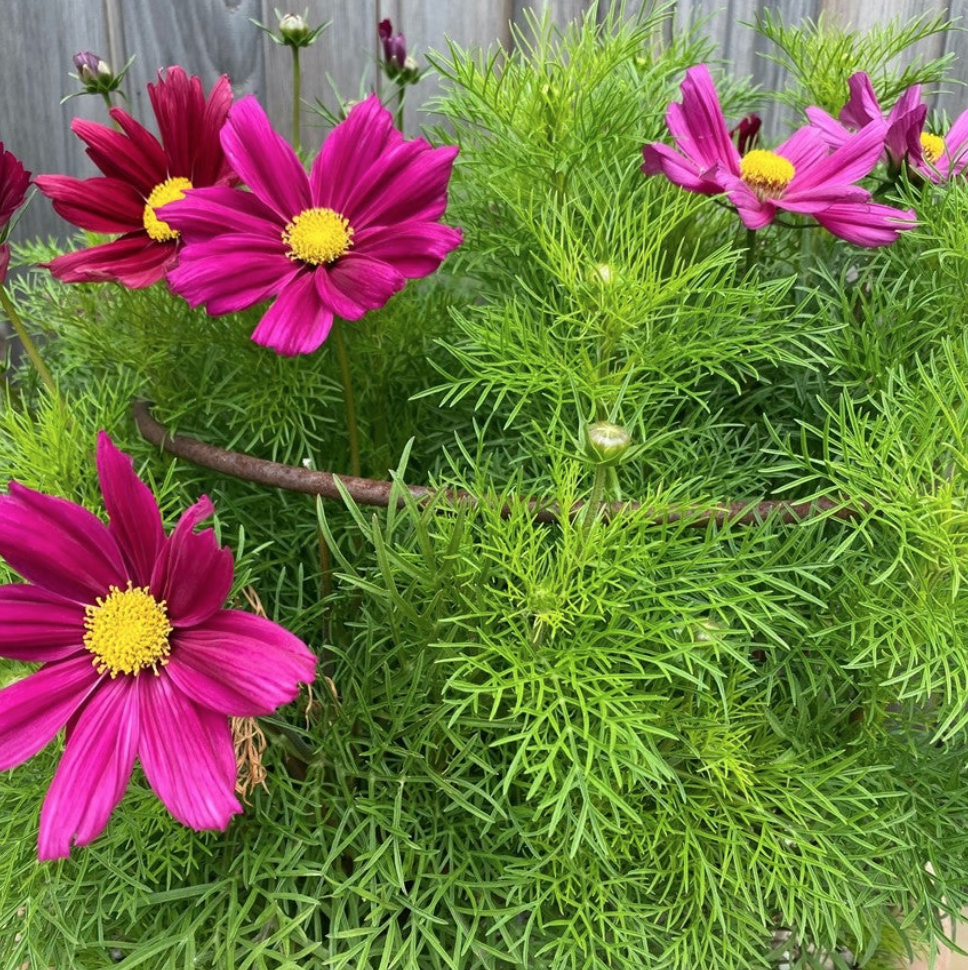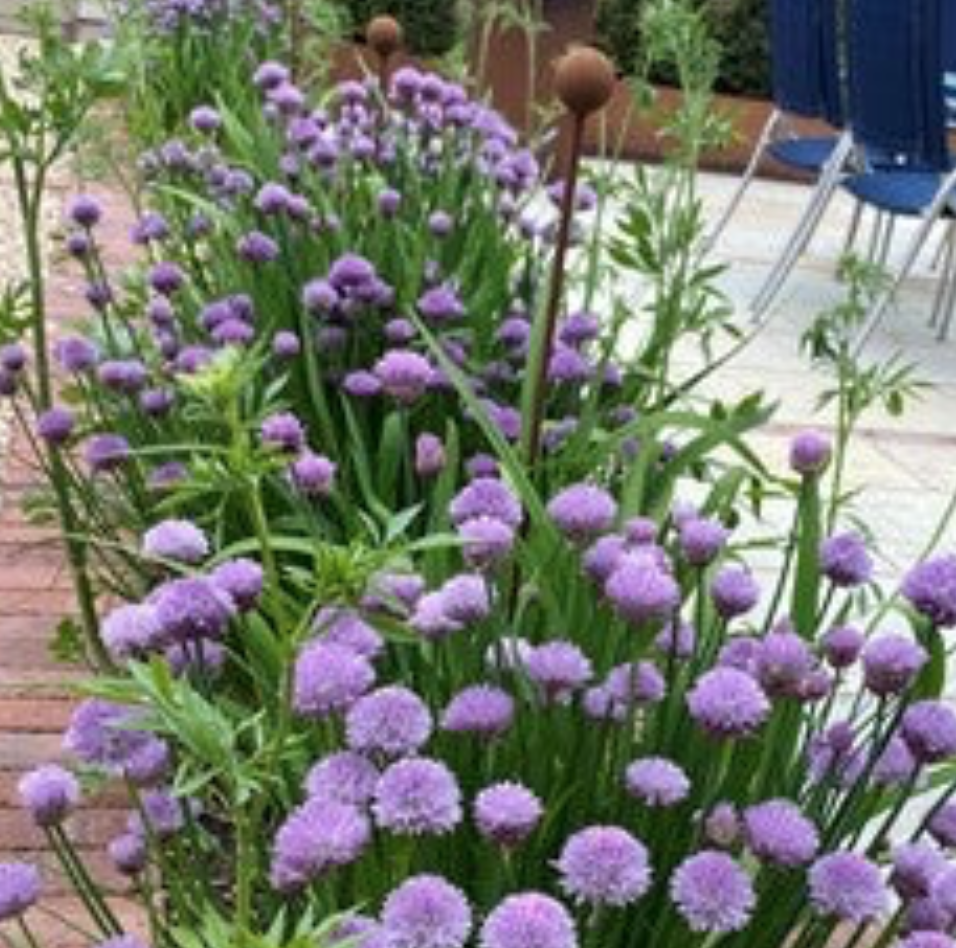
Plants that need supporting now Part 1: Herbaceous Plants
Lesley Ann Sandbach
A couple of miles from its source near Kemble, the Thames looks as if Ratty and Mole could scull round the corner at any moment.

Peony in its 2-ring regular peony support.

Hydrangea ‘Annabelle’ in her large 3-ring herbaceous support.
As always with the weather in Britain, it is impossible to predict what the year will bring and when the growing season will start. This year has been particularly challenging for those of us who long to get out into their gardens and start planting: an exceptionally cold April (what happened to those soft, misty rains that characterised the Aprils of my memory?) was followed by the wettest May on record in some parts of the country. The young Thames, which is often dry by this time of year, is still flowing strongly as it passes my neighbour’s boundary.

Cosmos held upright by a small semi-circular support.

Phlox paniculata ‘Blue Evening’ supported by a 1-ring medium herbaceous support

A border of chives and Ammi Majus is kept in control with stakes
Like so many of us, including some very experienced gardening friends, I became convinced at the first sign of warm weather in early May that summer had arrived. I have always had the luxury of a greenhouse until we moved to Gloucestershire but these days I use a light-filled spare bedroom to start my vegetable seeds and, because it’s difficult to regulate the temperature, they tend to grow too fast. I was so impatient to get growing that I lost the whole of my first sowing of runner beans and French climbing beans to a combination of wind and frost; my dahlias suffered leaf burn and a number of little plants in my cutting bed came to a full stop. I was distressed to note that every panicle on my neighbour’s wisteria shrivelled overnight, robbing us both of one of the delights of Spring.
However, the winds dropped, the frost lifted and warmth began to spread across the garden urging plants into that wonderful, green surge that gladdens the heart. They thrust upwards and suddenly we remember that we have omitted to put in those essential supports earlier in spring.
However, all is not lost. You can still get supports over your herbaceous clumps. Using lassoes of string, gently tie the stems into columns narrower than the support; slipping the support gently over (two people make this a job much easier) and then cutting the lasso to release the plant into the support.
Today I walked round the garden and photographed the 6 herbaceous supports that I use everywhere and could not be without. Here they are to provide you with a bit of help and inspiration; if not for this year then next.
Peony Baskets:
Although peony plants are strong, the flower heads are very heavy; wind and rain will make the plants collapse. The peony in the foreground has a ‘regular’ support and the one in the background a ‘tall’ one. Get them on as early as possible and leave them on – there’s no need to take the supports off in winter.
Also good for: alstroemerias, nepetas, sedums, asters.
Three ring herbaceous supports:
I love Hydrangea Arborescens ‘Annabelle’ but there is no doubt that, like peonies, she does have a tendency to flop just when her heavy heads are at their most beautiful. I cut my plants back hard in late winter and leave them to grow up inside a 3-ring herbaceous support – it gives just enough support to keep the flower heads from collapsing but does allow the plant to show its soft habit.
3-ring supports, with or without grids, can also be used for: tall asters; dahlias; soldigo; any other tall herbaceous plants, such as Rudbeckia laciniata, that tend to fall forward or lean towards the light.
Semi Circular supports:
Semi-circular supports are essential in the herbaceous border for holding back vigorous plants or preventing one layer falling forward onto the layer in front. One of my favourite colour combinations is the deep burgundy of Cirsium rivulare 'Atropurpureum' (the wonderfully named Melancholy Thistle) with Euphorbia palustris. The euphorbia pictured above is very vigorous and needs holding upright – the medium semi-circulars are already barely visible but I have used them throughout this planting to stop the euphorbias collapsing onto the other plants in the border. In the other picture, a small pair of semi-circular supports keep a clump of cosmos upright in a pot.
Useful for: anything that tends to flop; nepetas; rudbeckias; Alchemilla mollis; Veronicastrum verginicum; Verbena bonariensis
One ring herbaceous supports:
Another essential support to pop over herbaceous clumps to keep them upright without constraining them. Above a clump of Phlox paniculata ‘Blue Evening’ is supported in a border where Anemone hybrida ‘Honorine Jobert’ is threatening to take over (a valuable autumn plant but a thug!).
Use for any herbaceous clumps – we supply 3 sizes for everything from sedums and nepeta to helleniums and crocosmia.
Ornamental grass support:
We originally designed this straight-sided two-ring herbaceous support at the request of clients who wanted to keep tall, ornamental grasses under control. Here I am growing Molinia caerulae in a narrow border; by September its purple-tinged flower heads will shoot from the top of the support like fireworks.
But don’t be constrained by a name, this can be used for anything tall that needs confining: vernonicastrums would be happy in this, as would any other tall perennial.
Stakes:
It goes almost without saying that stakes are a garden essential! Our steel stakes, available in 8mm or 12mm diameter and in 4 lengths are topped with a steel ball – an elegant finish and, we hope, protection again accidental stabbings. I have used 8mm stakes down 2 narrow paths flanking a pathway. At the moment, the chives are strong and straight but later a haze of Ammi majus will set off the deep purple of Iris ensata and the ammi’s floppy stems will be tied in loosely to the stakes to prevent them falling across the pathway.
Use them: in threes or fives around large clumps and run string round them to provide an instant support for plants that have gone too far for an enclosed support – dahlias come to mind here. Run them in chevrons along the back and middle of a large herbaceous border and tie string along the lines to provide a gentle support for clumps that flop forwards as they grow.
Next time I shall look at the essential supports for those stars of the show – the climbers. Meanwhile you can browse our complete range of plant supports and steel cut outs at www.muntons.net
Follow us on Pinterest for more advice and inspiration for your English country garden: www.pinterest.co.uk/plantsupports
Follow us on Instagram: www.instagram.com/muntons_plant_supports
Follow us on Facebook: https://www.facebook.com/muntonstraditionalplantsupports
Only the echinacea and geum are reliably hardy so I can change the emphasis and correct imbalances over the years.
What else am I thinking about in the garden this month?
-
The wild flower meadow has been mown, the cut flowers and grasses allowed to lie in the meadow to drop their seeds (many wild flowers are annuals and grow each year from fresh seed) and then the cuttings collected (essential to stop the soil becoming enriched by the rotting material)
-
Bulbs: there’s still time to order your bulbs for planting in October (most bulbs including daffodils and alliums) and November (tulips) but don’t leave it too late as many of the popular varieties (including my favourite Narcissus Cyclamineus ‘Jenny’) sell out early
-
September to early October is the ideal time to lift and divide perennials to give them a chance to establish while the soil is still warm. Cut off and remove any top growth; work a fork gently round the plant teasing the roots free; lift the plant with as much of the root ball as possible; divide the clumps by pulling them apart by hand; teasing them apart with two forks or using a spade to slice congested clumps into fist-sized pieces. Get them back into the ground as soon as possible, water in well and give yourself a moment’s delight in your free plants
-
Harvest your vegetable crops: pick runner beans and French beans regularly when they are small and sweet; cucumbers and courgettes too need constant picking if they are to keep producing; lift potatoes and onions but some vegetables, like carrots and parsnips, benefit from being left in the ground as their flavour improves with some exposure to cold
I hope that’s given you some food for thought!
Follow us on Pinterest: www.pinterest.co.uk/plantsupports
Follow us on Instagram: www.instagram.com/muntons_plant_supports
Follow us on Facebook: https://www.facebook.com/muntonstraditionalplantsupports
